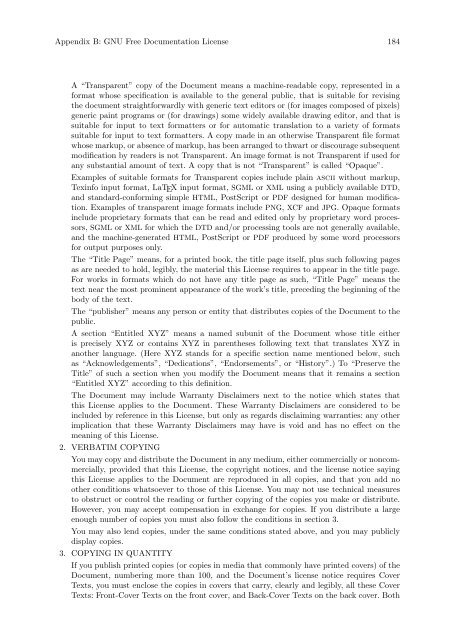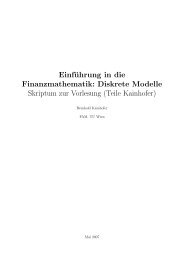LilyPond Beginnershandleiding
LilyPond Beginnershandleiding
LilyPond Beginnershandleiding
You also want an ePaper? Increase the reach of your titles
YUMPU automatically turns print PDFs into web optimized ePapers that Google loves.
Appendix B: GNU Free Documentation License 184<br />
A “Transparent” copy of the Document means a machine-readable copy, represented in a<br />
format whose specification is available to the general public, that is suitable for revising<br />
the document straightforwardly with generic text editors or (for images composed of pixels)<br />
generic paint programs or (for drawings) some widely available drawing editor, and that is<br />
suitable for input to text formatters or for automatic translation to a variety of formats<br />
suitable for input to text formatters. A copy made in an otherwise Transparent file format<br />
whose markup, or absence of markup, has been arranged to thwart or discourage subsequent<br />
modification by readers is not Transparent. An image format is not Transparent if used for<br />
any substantial amount of text. A copy that is not “Transparent” is called “Opaque”.<br />
Examples of suitable formats for Transparent copies include plain ascii without markup,<br />
Texinfo input format, LaTEX input format, SGML or XML using a publicly available DTD,<br />
and standard-conforming simple HTML, PostScript or PDF designed for human modification.<br />
Examples of transparent image formats include PNG, XCF and JPG. Opaque formats<br />
include proprietary formats that can be read and edited only by proprietary word processors,<br />
SGML or XML for which the DTD and/or processing tools are not generally available,<br />
and the machine-generated HTML, PostScript or PDF produced by some word processors<br />
for output purposes only.<br />
The “Title Page” means, for a printed book, the title page itself, plus such following pages<br />
as are needed to hold, legibly, the material this License requires to appear in the title page.<br />
For works in formats which do not have any title page as such, “Title Page” means the<br />
text near the most prominent appearance of the work’s title, preceding the beginning of the<br />
body of the text.<br />
The “publisher” means any person or entity that distributes copies of the Document to the<br />
public.<br />
A section “Entitled XYZ” means a named subunit of the Document whose title either<br />
is precisely XYZ or contains XYZ in parentheses following text that translates XYZ in<br />
another language. (Here XYZ stands for a specific section name mentioned below, such<br />
as “Acknowledgements”, “Dedications”, “Endorsements”, or “History”.) To “Preserve the<br />
Title” of such a section when you modify the Document means that it remains a section<br />
“Entitled XYZ” according to this definition.<br />
The Document may include Warranty Disclaimers next to the notice which states that<br />
this License applies to the Document. These Warranty Disclaimers are considered to be<br />
included by reference in this License, but only as regards disclaiming warranties: any other<br />
implication that these Warranty Disclaimers may have is void and has no effect on the<br />
meaning of this License.<br />
2. VERBATIM COPYING<br />
You may copy and distribute the Document in any medium, either commercially or noncommercially,<br />
provided that this License, the copyright notices, and the license notice saying<br />
this License applies to the Document are reproduced in all copies, and that you add no<br />
other conditions whatsoever to those of this License. You may not use technical measures<br />
to obstruct or control the reading or further copying of the copies you make or distribute.<br />
However, you may accept compensation in exchange for copies. If you distribute a large<br />
enough number of copies you must also follow the conditions in section 3.<br />
You may also lend copies, under the same conditions stated above, and you may publicly<br />
display copies.<br />
3. COPYING IN QUANTITY<br />
If you publish printed copies (or copies in media that commonly have printed covers) of the<br />
Document, numbering more than 100, and the Document’s license notice requires Cover<br />
Texts, you must enclose the copies in covers that carry, clearly and legibly, all these Cover<br />
Texts: Front-Cover Texts on the front cover, and Back-Cover Texts on the back cover. Both



